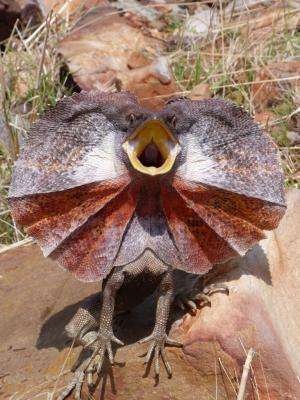Researchers find lizards' frilled neck is more than just for show

(Phys.org) —Researchers have discovered that the brightly coloured frills of the iconic Australian frillneck lizard (Chlamydosaurus kingii) can be used to predict the animals fighting ability.
In a recent paper published in Behavioral Ecology, researchers from Macquarie University and The Australian National University examined which traits were significant predictors of a male frillneck lizard's success when fighting.
Of those tested, two traits were identified as significant in contest success: body mass and the brightness of the lizard's frill colour. As expected, being bigger helped in 83% of the wins but what was surprising was that males with a more colourful frill patch won 90% of contests.
"Surprisingly, traits such as frill size, head size and bite force did not predict contest outcome. Instead, males with brighter and more colourful frills were more likely to dominate opponents and take gold," says biologist Dr Martin Whiting, Macquarie University.
This is significant because you would expect a higher body mass to influence relative fighting ability, but in situations where there is no clear discrepancy in size between opponents the pigment levels appear to be a clear indicator."
The researchers tested levels of carotenoid pigmentation – responsible for the conspicuous yellow, orange, and red colours in the lizard's frill – and found a strong correlation between high levels of carotenoid and the lizard's ability to defeat a competitor when confronted. This is the first example of a carotenoid-based signal of fighting ability in a lizard.
"This is an exciting result because while carotenoids have been the source of considerable study among our feathered friends, we know little about the role of carotenoids in lizards," says Whiting.
Both males and females have frills and until now, the consensus has always been that frills primary role is in anti-predator behaviour. This new research indicates that the colours might also be important for signal fighting ability and play a role in sexual selection.
More information: Hamilton, D., Whiting, M. and Pryke, S. 2013. Fiery frills: carotenoid-based coloration predicts contest success in frillneck lizards. Behavioral Ecology doi: Article first published 20 May 2013, beheco.oxfordjournals.org/cont … 0/beheco.art041.full
Journal information: Behavioral Ecology
Provided by Macquarie University


















